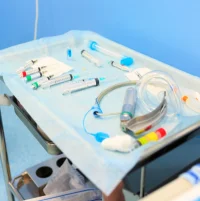In a large single centre study, 21 percent of intubated patients who received infusions of vasoactive infusions while mechanically ventilated were extubated for the first time while still receiving them. Coincident with their earlier extubation, these patients' ICU length of stay was shorter without an increase in ICU mortality, hospital mortality or reintubation rate, suggesting that this can be safe practice, according to the study to appear in the American Journal of Respiratory and Critical Care Medicine.
The findings "suggest that current U.S. clinical trial practice and guidelines may be unnecessarily conservative. In the modern era of lung protective ventilation and reduced sedation, patients may be otherwise ready to extubate prior to full return of haemodynamic stability. Contrary to current practice in recent and ongoing U.S. clinical trials, these data suggest it may be safe to do so in select situations," the study says.
Discontinuation of vasopressors or inotropes is a common pre-condition for spontaneous breathing trials or extubation in U.S. clinical trials and guidelines. A contrary view is that such a delay increases patients’ risks for the complications of endotracheal intubation and mechanical ventilation and may mandate additional intensive care unit (ICU) time, decreasing throughput and effective ICU capacity.
Glasgow Royal Infirmary ICU (GRI) extubates select patients while on vasopressors or inotropes ("vasoactive infusions"), but the safety of this procedure has never been formally evaluated. Clinical practice is to extubate patients — at the attending physician’s discretion — who have minimal ventilatory and oxygen support, an adequate cough, and ideally are able to participate with physiotherapy.
Tara Quasim MD, MPH, MBChB, Glasgow Royal Infirmary, Intensive Care Unit, Scotland, UK, and colleagues conducted this retrospective study to evaluate whether extubations attempted while patients are still on vasoactive infusions are associated with different ICU mortality (primary outcome) than extubations attempted after the infusions have been stopped. Secondary outcomes included reintubation, hospital mortality, and ICU and hospital lengths of stay. All GRI patients intubated from January 2007 to February 2017, who received a vasoactive infusion while intubated, were included in the study. De-identified data were extracted from operational electronic data systems. Multivariable logistic regression was used for adjustment for ICU admission characteristics.
After applying exclusion criteria, the primary study cohort consisted of 1,266 patients: 280 patients (21 percent) extubated on vasoactive infusions and 986 extubated after discontinuation. Patients extubated on vasoactive medications were somewhat less ill at presentation (APACHE II 19 vs. 21, p=0.007). Researchers reported these key findings:
- There was no difference in ICU mortality between the two groups: n=18 deaths (6.4%) on vasoactive medications vs. n=80 (8.1%) off, p=0.42); also no statistically significant difference in in-hospital mortality n=51 (18.2%) vs. n=137 (13.9%).
- There was no difference in the in-ICU reintubation rate between the two groups (n=30 reintubations (10.7%) on vasoactive infusions vs. n=120 (12.2%), p=0.58.
- Patients extubated on vasoactive infusions had a slightly shorter ICU stay after extubation (2 days vs. 2.2 days, p=0.049), but a shorter overall ICU LOS (5 days vs. 9 days, p<0.001) and duration of mechanical ventilation (2 days vs. 6 days, p<0.001).
Also, after multivariable adjustment for differences between the groups at ICU admission — including age, APACHE II, dialysis during ICU stay, and ICU diagnosis — there is no significance difference for any of the outcomes between those extubated on vasoactive agents and those extubated not on vasoactive agents (hospital mortality adjusted p value = 0.0805, unit mortality adjusted p-value = 0.332 and reintubation adjusted p-value = 0.8383).
"These data do not prove that extubation on vasoactive agents is always as safe as other extubations. Instead, they call for the development of protocols for identifying patients who can be safely extubated despite continued vasoactive infusions — thereby speeding ICU recovery — and the rigorous testing of such protocols in randomised evaluations," the study authors write.
Image Credit: Calleamanecer
References:
Quasim T et al. (2018) Safety of Extubating Mechanically Ventilated Patients on Vasoactive Infusions: A Retrospective Cohort Study. Am J Respir Crit Care Med, Articles in Press. Published on 28 June 2018 as 10.1164/rccm.201712-2492LE
Latest Articles
Intubation, extubation, vasoactive agents
In a large single centre study, 21 percent of intubated patients who received infusions of vasoactive infusions while mechanically ventilated were extubated for the first time while still receiving them. Coincident with their earlier extubation, these pat










